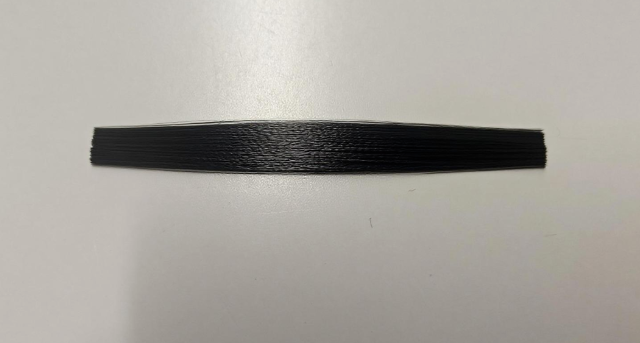When a bundle of carbon fiber filaments with a diameter of only a few micrometers carries five times the strength of steel with one-fifth of its weight, the boundaries of human materials engineering are redefined. Short cut carbon fiber - this bundle of "black gold" has been transformed into millimeter scale material through cutting technology, reshaping the backbone of industries such as automobiles, aerospace, electronics, etc. with its lightweight and high-strength characteristics. However, precisely cutting continuous carbon fiber into short cut fibers that meet strict industrial standards is like carving patterns on hair, testing the ultimate precision of modern manufacturing technology. GW Guanghui Laser uses high brightness fiber lasers as its cutting edge, opening up a new path that combines efficiency and quality on this micron scale battlefield.
Carbon fiber filament: a strength miracle in the microscopic world
Carbon fiber yarn is a continuous fiber made by high-temperature carbonization of polyacrylonitrile (PAN) precursor, with a diameter of only 5-10 microns. It has a tensile strength of up to 3000 MPa and an elastic modulus of 200 GPa, combined with acid and alkali corrosion resistance and a thermal expansion coefficient approaching zero, making it the core material of the lightweight revolution. When these continuous fibers are cut into 3-12mm short cut fibers, they transform from "flexible long lines" to "reinforced cores" - after being composite with thermoplastic resin, they can be injection molded into automotive chassis components, reducing the weight of the entire vehicle by more than 15%; Incorporating wind turbine blade matrix can improve fatigue resistance by up to 30%; Even in the electromagnetic shielding cover of 5G base stations, the dual advantages of conductivity and thermal conductivity can balance structural strength and signal stability.
From the lightweight modification of Tesla battery cases, to the anti drop design of DJI drone racks, to the wear-resistant components of high-speed rail pantographs, the presence of short cut carbon fibers has penetrated into the capillaries of high-end manufacturing. According to industry data, the global market size of short cut carbon fiber will reach 432 million US dollars in 2024, with the automotive sector accounting for over 40%. China, with a global share of 26.42%, is becoming the main battlefield of this material revolution.
Cutting Difficulty: Seeking Balance in "Overcoming Strength with Softness"
The cutting of carbon fiber filaments is the ultimate test of technical accuracy. This composite material, composed of countless microfilaments, has a dual personality of "rigidity" and "flexibility": its axial strength is comparable to steel, but its transverse strength is fragile like glass; When cutting, it is necessary to cut off high-strength fiber bundles while avoiding fiber fuzzing and matrix cracking caused by mechanical stress. The traditional mechanical shearing process is like cutting silk with a blunt knife, either due to blade wear resulting in a burr rate of over 20%, or due to extrusion stress causing fiber length deviation of more than 3%, seriously affecting the consistency of mechanical properties of composite materials.
The more challenging aspect is the adaptability to multiple scenarios. When 6mm short cut fibers are used for automotive injection molded parts, the length tolerance is required to be controlled within ± 0.1mm; However, 12mm fibers used in aerospace have nanometer level requirements for the flatness of the incision. When the cutting length is shortened to less than 1mm, the rigidity defects of mechanical cutting tools become increasingly apparent, and the processing efficiency drops by more than 50%, while the cost skyrockets by three times. In addition, the conductivity of carbon fiber may also cause arc interference in traditional thermal cutting equipment, posing potential quality hazards in the cutting of fibers used in electronic and electrical components.
Laser Blade: The Breakthrough of GW High Brightness Fiber Laser

Faced with the many constraints of carbon fiber cutting, GW Guanghui Laser has built a new solution of "optical knife cutting" with high brightness fiber laser as the core. After focusing the laser beam, the diameter of the spot can be reduced to several tens of microns, and fiber vaporization cutting can be completed in microseconds, achieving precision machining with a "heat affected zone less than 5 microns" - this is equivalent to cutting on a single hair thread, affecting only 1/20 of the surrounding hair diameter area.
This non-contact cutting method fundamentally solves the inherent defects of mechanical shearing: the laser beam's wear free characteristics ensure that the length tolerance can still be stably controlled within ± 0.05mm after continuous cutting of 1 million meters of fibers; the high-energy density instantly melts the fiber end face, significantly improving the interfacial bonding strength of composite materials. For different application scenarios, the GW laser system can accurately adjust the cutting length through software, perfectly adapting to the flexible production needs of multiple fields such as automobiles and aviation.
More noteworthy are its efficiency and cost advantages. The electro-optical conversion efficiency of GW high brightness fiber lasers exceeds 43%, saving more than 50% energy compared to traditional CO ₂ lasers; A single device can cut hundreds of kilograms of carbon fiber silk per hour, which is three times more efficient than mechanical cutting. In the current rapid expansion of new energy vehicles, the dual advantages of "high precision+high efficiency" are helping short cut carbon fiber break through the cost bottleneck and accelerate the replacement of traditional metal and glass fiber materials.
When carbon fiber filaments are precisely cut by laser and transformed into millions of reinforcement units integrated into the texture of modern industry, GW Guanghui Laser not only showcases the technological edge of China's high-end manufacturing, but also drives the deep evolution of the lightweight materials revolution with innovative power. In this precision competition of the microscopic world, every trace drawn by the laser beam is a necessary path towards a lighter, stronger, and more efficient future.
 0
0
